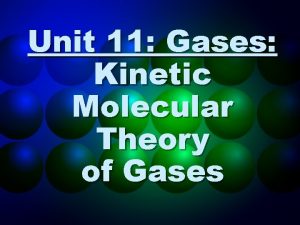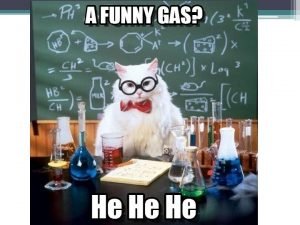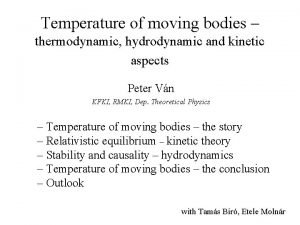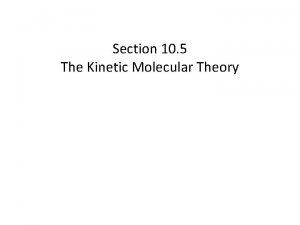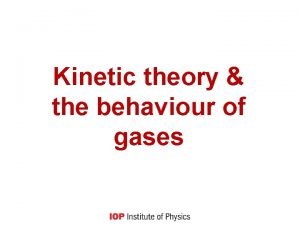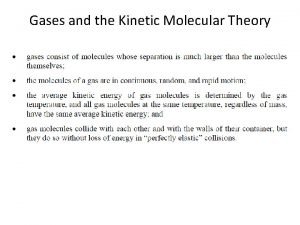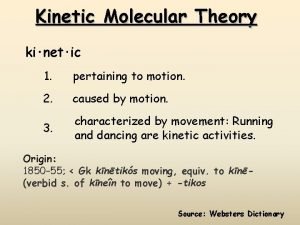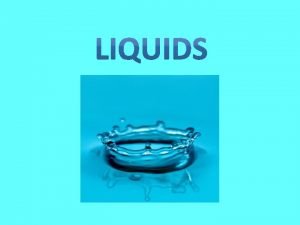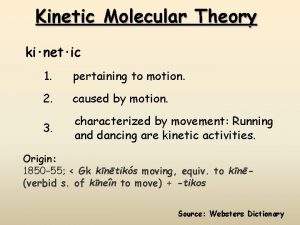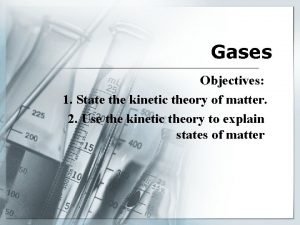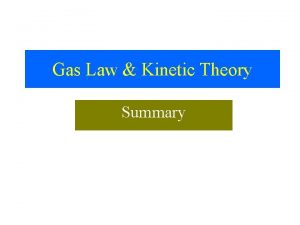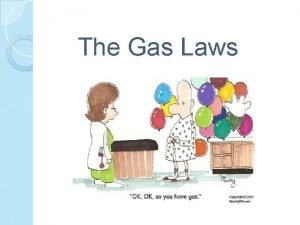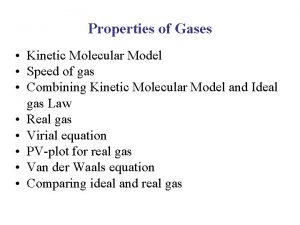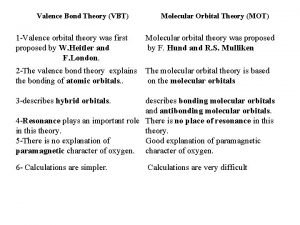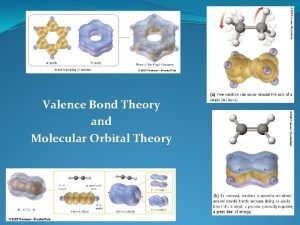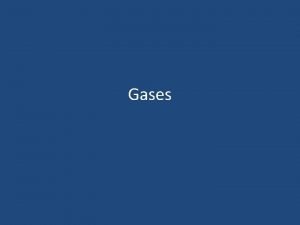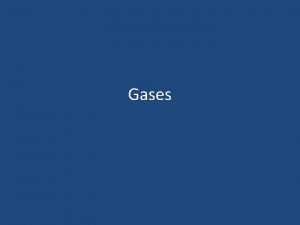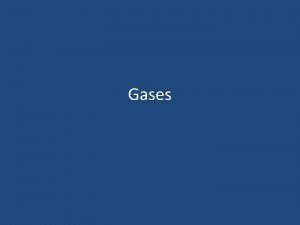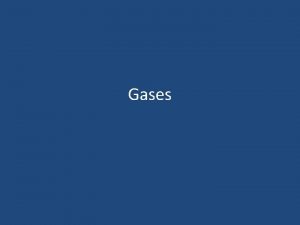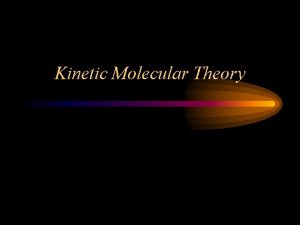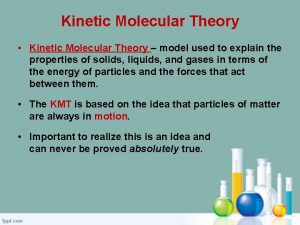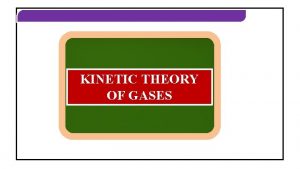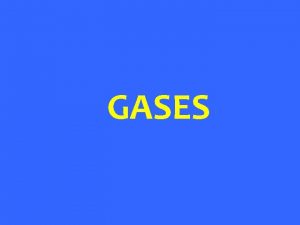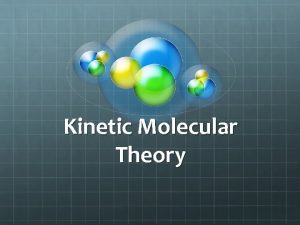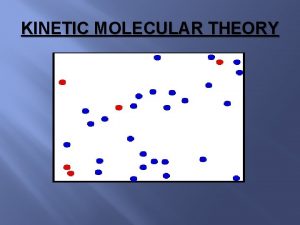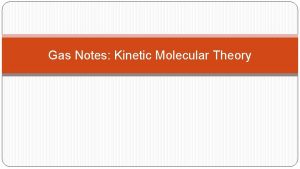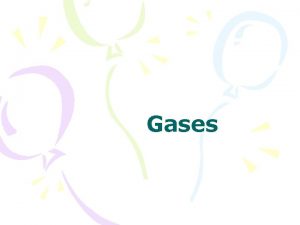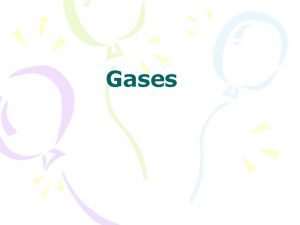Kinetic Molecular Theory The model of Gases Most























- Slides: 23

Kinetic Molecular Theory

The model of Gases Most of our knowledge of gases comes from a model of how gases work. The model of a real gas would look something like a large open room filled with several bouncing balls flying around at very high speeds (2 x the speed of sound) If the room was about the size of this classroom, the “balls” could be kept in the mole box.

Dalton’s Law of Partial Pressure John Dalton found that in a mixture of gases, the pressure each gas exerts is the same as if it were alone in the container. The total pressure of all gases is the sum of each partial pressure of the gases present P = P 1 + P 2 + P 3…

If you have two containers . 5 mol of N 2 2. 4 atm 1. 5 mol of H 2 7. 2 atm And I force both of these gases into one. 5 mol of N 2 2. 4 atm 1. 5 mol of H 2 7. 2 atm The total pressure would be 9. 6 atm

Therefore PV = n. RT P = n. RT/V Using Dalton’s law of partial pressure for a mixture of two gases Ptotal = n 1 (RT/V) +n 2 (RT/V)… Ptotal = (n 1 + n 2…) (RT/V) Ptotal = ntotal (RT/V)

Implications When calculating pressure, the total number of gas particles in the only thing that is important. The type of gas particle is irrelevant. The mass of the atom/molecule or volume atom/molecule is irrelevant.

Kinetic Molecular Theory Laws explain “what” Theories try to explain “why” Theories can NEVER become laws. The kinetic molecular theory explains why gases act the way they do. Gases that act like the kinetic molecular theory predicts are called ideal gases.

Ideal Gases consist of tiny particles that have negligible volume compared with the overall volume of the gas. Atoms/molecules are in constant random motion, that constantly collide with one another and the wall of the container. There is no attraction, repulsion or “desire” of the gas particles to go anywhere. The result of these collisions is the pressure exerted by the gas.

More on ideal gases All collisions are elastic, which means no kinetic energy is lost (to sound, light or heat energy). The temperature of a gas relates to the average speed of each individual atom/molecule (kinetic energy) depending upon the mass as well. KE = ½ mv 2

Real Gases Most real gases will act like ideal gases under normal conditions. Under extremely high pressure or extremely low temperatures a gas no longer acts like an ideal gas.

Diffusion Effusion

Diffusion ~Movement of particles from an area of high concentration to an area of low concentration. This is why you can smell perfume all throughout a room when it is sprayed. Using the ideal gas model- you wouldn’t expect a certain type of atoms to stay together.

High Diffusion Low All particles move randomly. There is no desire to travel anywhere. However, there are more particles at high pressure than low pressure. So the probability of particles going from high to low is higher than from low to high.

Diffusion On the last slide say there were 5 particles at low pressure and 100 at high pressure. Each particle has a 1/5 chance of moving from 1 circle to the other. What happens? 1 moves from low to high 20 move from high to low That means we have a net flow of 19 particles from high to low. To make it a reasonable amount we really need much more than 100 particles to start so put a x 1020 at the end of all numbers.

Effusion ~a movement of particles from high to low concentration through an opening. Like a tire with a leak in it. Really this only depends on the likelihood of a particle reaching the “hole”. Which is dependant upon the number of particles present and the speed of

Tire with a leak The particle inside have a higher pressure than the particles outside. Tire The material will be weak on either side and open like flaps That means there is more gas particles on the inside than on the outside Therefore they should hit the hole and escape more often than outside particles.

Tire with a leak Any individual particle inside or outside of the tire should have the same chance of hitting the “hole”. The particles inside have a higher pressure than the particles outside. Which means there are more particles in a given area inside the tire than outside. Tire Therefore more inside particles should hit the hole than outside The material will particles, and there should be be weak on either net flow of side and open like air particles outward. flaps

Comparing the rates of effusion of gas molecules All gases will not effuse at the same rate. It depends on the speed of each gas molecule. At the same temperature, all particles will have the same kinetic energy, but they all have different masses (their molar mass).

What that means A bowling ball with the same amount of kinetic energy as a golf ball must be moving significantly slower, right? Imagine that at an atomic level. Heavier particles move more slowly than lighter particles if they both are at the same average kinetic energy (temperature)

Oxygen and hydrogen at the same temperature If they have the same temperature, the kinetic energy will be equal. ½ mv 2 oxygen = ½ mv 2 hydrogen ½ 32 v 2 oxygen = ½ 2 v 2 hydrogen 16 v 2 oxygen = v 2 hydrogen 4 v oxygen = v hydrogen So hydrogen has to move 4 x as fast as oxygen to have the same kinetic energy

4 x the speed means… It should effuse 4 x as fast. And experiments show it does. If you have a container holding both H 2 and O 2 the hydrogen should leave 4 x more quickly than oxygen. Graham’s Law of effusion va/vb = Mb/Ma (under the same conditions) M is the molar mass

Quick example va/vb = Mb/Ma So carbon dioxide and water vapor v. H 2 O/v. CO 2 = 44. 01/18. 016 v. H 2 O/v. CO 2 =1. 563 Meaning water vapor will effuse 1. 563 x as fast as carbon dioxide. ------or-------v. CO 2/v. H 2 O = 18. 016/44. 01 v. CO 2/v. H 2 O =. 6398 Meaning carbon dioxide will effuse. 6398 x as fast as water vapor.

Homework Compare the rates of effusion of sulfur dioxide, SO 2, to neon gases
 Kinetic molecular model of gases
Kinetic molecular model of gases Particle theory evaporation
Particle theory evaporation Kinetic theory of gases
Kinetic theory of gases Postulates of kinetic theory
Postulates of kinetic theory Kinetic theory
Kinetic theory Write the postulates of kinetic theory of gases
Write the postulates of kinetic theory of gases Postulates of kinetic theory of gases
Postulates of kinetic theory of gases General gas equation is
General gas equation is Molecular theory of gases and liquids
Molecular theory of gases and liquids Kinetic molecular theory of solids
Kinetic molecular theory of solids The kinetic molecular theory
The kinetic molecular theory Adhesive force
Adhesive force Kinetic molecular theory of liquids
Kinetic molecular theory of liquids Kinetic molecular theory
Kinetic molecular theory Kinetic molecular theory def
Kinetic molecular theory def Kinetic molecular theory timeline
Kinetic molecular theory timeline Charles law in terms of kinetic molecular theory
Charles law in terms of kinetic molecular theory Avogadro's law
Avogadro's law Kinetic molecular theory formula
Kinetic molecular theory formula Kinetic molecular theory
Kinetic molecular theory Tenets of kinetic molecular theory
Tenets of kinetic molecular theory Qumica
Qumica Molecular orbital diagram of f2
Molecular orbital diagram of f2 Valence bond theory and molecular orbital theory
Valence bond theory and molecular orbital theory


